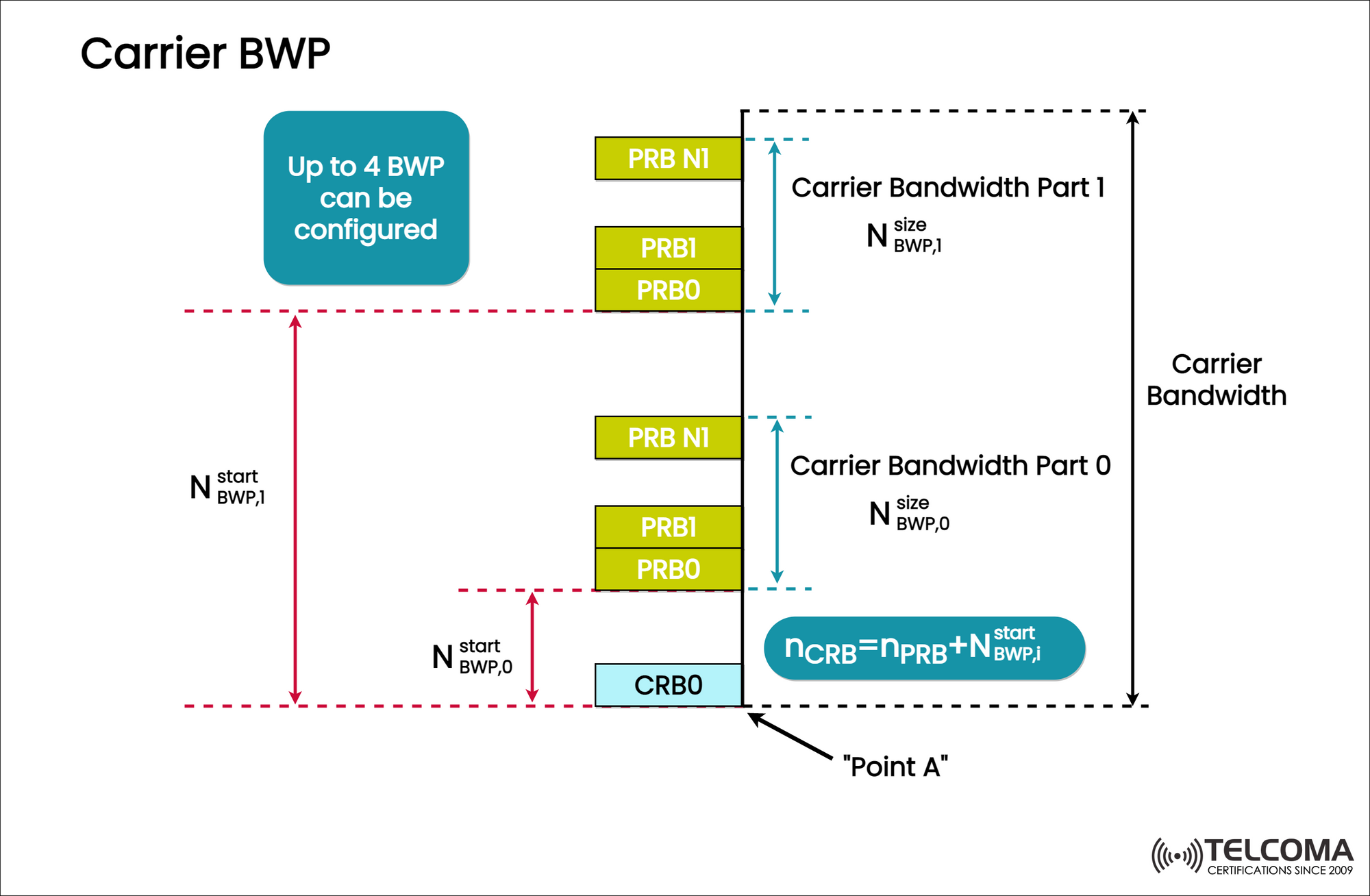5G NR Bandwidth Part (BWP)


Introduction:
Bandwidth Part (BWP) is an essential feature of the 5G New Radio (NR) system. It is a configurable entity that allows the allocation of the bandwidth in the frequency domain for the transmission and reception of the data. A BWP can be defined as a subset of the total system bandwidth allocated to a specific user or group of users. The BWP enables flexible allocation of the available bandwidth and helps to improve the spectrum efficiency of the system. This paper discusses the technical aspects of the 5G NR Bandwidth Part (BWP), including its concept, functionality, and its advantages.

Concept of 5G NR Bandwidth Part (BWP):
In 5G NR, the BWP can be defined as a contiguous set of Resource Blocks (RBs) that are allocated to a specific user or group of users. The RB is the smallest unit of resources in the frequency domain and is defined as a block of subcarriers (frequency) and symbols (time). A BWP can be configured to a specific bandwidth, starting from the minimum system bandwidth to the maximum system bandwidth. The minimum bandwidth is 5 MHz, and the maximum bandwidth is 400 MHz. The BWP can also be configured to a specific location within the system bandwidth, which can be the center of the system bandwidth or any other location within the system bandwidth.
Functionality of 5G NR Bandwidth Part (BWP):
The BWP in 5G NR provides flexibility in the allocation of the available bandwidth. It allows the allocation of the system bandwidth to a specific user or group of users based on their specific requirements. For example, a BWP can be configured to allocate a specific bandwidth to a user who requires a higher data rate, while a smaller bandwidth can be allocated to a user who requires a lower data rate. The BWP also enables efficient use of the available bandwidth by avoiding the wastage of unused resources.
The BWP has two main modes of operation, namely, the Intra-band BWP and the Inter-band BWP. In the Intra-band BWP mode, the BWP is configured within the same frequency band as the system bandwidth. In the Inter-band BWP mode, the BWP is configured within a different frequency band from the system bandwidth. The Inter-band BWP mode is particularly useful in cases where the system bandwidth is heavily congested, and the allocation of additional bandwidth is not possible within the same frequency band.
The BWP also enables the dynamic allocation of the available bandwidth to the users. In 5G NR, the BWP can be configured to support dynamic switching between the different BWPs. This enables the allocation of the available bandwidth to the user based on their changing requirements. For example, the BWP can be configured to allocate a higher bandwidth to a user who is streaming a video, while a lower bandwidth can be allocated to a user who is browsing the web. The dynamic switching between the different BWPs is performed based on the feedback received from the user equipment (UE) and the network.
Advantages of 5G NR Bandwidth Part (BWP):
The BWP in 5G NR provides several advantages that improve the performance of the system. These advantages include:
- Improved spectrum efficiency: The BWP enables efficient use of the available bandwidth by avoiding the wastage of unused resources. This results in improved spectrum efficiency and increased data rates.
- Flexibility in the allocation of bandwidth: The BWP allows the allocation of the available bandwidth to a specific user or group of users based on their specific requirements. This results in the efficient utilization of the available resources and improved user experience.
- Dynamic allocation of bandwidth: The BWP enables dynamic switching between the different BWPs based on the changing requirements of the users. This improves the allocation of the available resources and ensures that the users receive the required bandwidth for their applications.
- Interference reduction: The BWP also helps in reducing interference in the system. The allocation of the bandwidth to a specific user or group of users ensures that the interference is minimized, and the system performance is optimized.
- Interoperability: The BWP in 5G NR is also designed to ensure interoperability between different networks and devices. The BWP can be configured to support different bandwidths, which ensures that the system can operate with different devices and networks.
Technical details of 5G NR Bandwidth Part (BWP):
The BWP in 5G NR is a configurable entity that is defined by two parameters, namely the BWP size and the BWP location. The BWP size refers to the number of Resource Blocks (RBs) allocated to the BWP, while the BWP location refers to the position of the BWP within the system bandwidth. The BWP size and location can be configured by the network or the user equipment (UE) based on their specific requirements.
The BWP is defined as a contiguous set of RBs, and the minimum BWP size is one RB. The BWP size can be increased in steps of two RBs, up to a maximum of 273 RBs for the maximum system bandwidth of 400 MHz. The BWP size is also limited by the maximum transmission bandwidth of the UE.
The BWP location can be configured to a specific location within the system bandwidth, which can be the center of the system bandwidth or any other location within the system bandwidth. The BWP location is defined by two parameters, namely the BWP start frequency and the BWP subcarrier spacing. The BWP start frequency refers to the starting frequency of the BWP, while the BWP subcarrier spacing refers to the frequency spacing between the RBs in the BWP.
The BWP can also be configured to support different numerologies, which refers to the spacing between the subcarriers and the symbols in the time-frequency grid. The 5G NR system supports different numerologies, which are defined by different subcarrier spacings and symbol durations. The BWP can be configured to support any of the supported numerologies, which enables the system to operate with different devices and networks.
Conclusion:
The 5G NR Bandwidth Part (BWP) is an essential feature of the 5G NR system that enables efficient allocation of the available bandwidth. The BWP provides flexibility in the allocation of the bandwidth to the users based on their specific requirements. The BWP also enables dynamic switching between the different BWPs based on the changing requirements of the users. The BWP provides several advantages that improve the performance of the system, including improved spectrum efficiency, flexibility in the allocation of bandwidth, dynamic allocation of bandwidth, interference reduction, and interoperability. The BWP in 5G NR is a configurable entity that is defined by two parameters, namely the BWP size and the BWP location. The BWP size and location can be configured by the network or the user equipment (UE) based on their specific requirements. The BWP is defined as a contiguous set of RBs, and the BWP location is defined by two parameters, namely the BWP start frequency and the BWP subcarrier spacing. The BWP can also be configured to support different numerologies, which enables the system to operate with different devices and networks.
